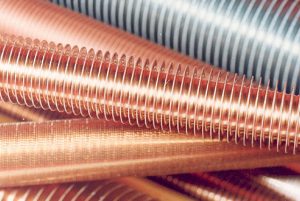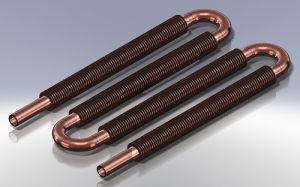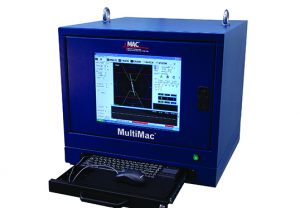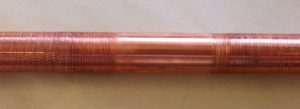FINNED TUBE
Metallic inclusions in copper tubing can be caused by two major sources. The first comes from the material itself which can contain residual impurities from continuous casting. The second, and major source of metallic inclusions in finned copper tubes, occurs during the manufacturing process. Inclusions that are the results of the manufacturing process can appear in the tube when the tool used to make the fins is breaking. Small particles of metal (tungsten) make inclusions on the OD or even through the wall. This leads to potential leaks when heat exchanger tubes are mounted in the shell.

- Metal inclusions from finning tools, can be can be very small. Because they are not commonly detected with a simple eddy current coil, a Magnetic Inclusion Detector (MID) using flux leakage technology must be introduced to the system.
- MultiMac® electronics use a second channel, which consists of a single absolute winding located in a DC field generated by two permanent magnets, to detect these small ferromagnetic inclusions, using flux leakage technology.
- MAC’s recommended inspection system for finned copper tube incorporates a 2-Channel MultiMac®, with Magnetic Inclusion Detector (MID), a CP10 Coil Platform, “ZZ” Magnetic Dual Coil and 3500 Pinch Stand.
- The dual coil sensor consists of one primary with its associated secondary arranged in differential mode for defect detection, and one single absolute winding for detection of metallic inclusions.
- The system detects surface ID and OD defects, splits, broken discs, metal incrustation, inclusions, tears and pin holes.
- Recommended for testing in HVAC equipment, refrigeration, appliances, and electronic cooling systems.

MULTIMAC®
- Lets you configure your eddy current test application the way you want—all with just one tester.
- Test channels can be individually configured for use with encircling or sector test coils as well as rotating test probes.
- Offers up to 8 test channels for use in any combination.
- Detects transverse, short and/or longitudinal, seam-type surface defects.
- Can operate on a wide variety of non-magnetic products or use direct current saturation to inspect magnetic material.

MAC’s eddy current inspection systems incorporate computer-based test instruments and test coils. The coils interact with the material under test and provide data that is processed and analyzed by the instrument. MAC uses two ECT coil technologies: Encircling and Sector Coils, and Spinning or Rotary Probe Coils.
Typical applications for encircling/sector eddy current testers are:
- Detecting short surface and some subsurface defects in wire, bar and tube.
- Inspecting welded tube for short ID or OD defects in the weld zone or on the full circumference.

Finned Copper Tube with Transitional (land) Zone

